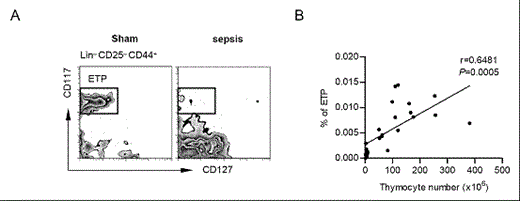Abstract
Emergency hematopoiesis is important for the host to replenish the loss of immune cells and meet the enhanced demand for appropriate immune cells during acute infection. Previous studies have explored several intrathymic mechanisms that negatively affect thymopoiesis and subsequentlycontribute to sepsis-associated immunosuppression. However, the extrathymic mechanisms remain poorly understood.
In line with previous studies, the mice subjected to cecal ligation and puncture developed severe T-cell lymphopenia. Moreover, lower numbers of T cell receptor circles excision circles (TRECs) were detected in septic mice when compared with control mice, which suggested a decrease in T-cell output from the thymus. Gross and histologic examinations and total thymus cellularity were in agreement with decreased thymic output. Next, we investigated whether sepsis affected intrathymic progenitors. There was a dramatic decline in the proportions as well as absolute numbers of early T-lineage progenitors (ETPs, Lin-CD117+CD44-CD25-CD127-) in the thymi of septic mice (Figure 1 A). Notably, the percentage of ETPs correlated positively with the number of thymocytes (r=0.6481, p=0.0005, Figure 1B).
However, septic mice did not show a decrease in the number of bone marrow (BM) precursor cells. Instead, transwell migration assay exhibited that compared with cells from control mice, lymphoid-primed multipotent progenitors (LMPPs) and common lymphoid progenitors (CLPs) from septic mice exhibited significantly reduced chemotaxis towards chemokine gradients, including CCL19, CCL25, and P-selectin. In line with these results, real-time PCR revealed decreased mRNA levels of CCR7 (receptor of CCL19 and CCL21), CCR9 (receptor of CCL25), and P-selectin glycoprotein ligand (PSGL)1 in BM LMPPs and CLPs from septic mice when compared with control mice. In contrast, thymic tissues of septic mice expressed higher levels of mRNA for CCL19, CCL21 and CCL25. Thus, decreased expression of chemokine receptors might contribute to impaired chemotaxis of BM lymphoid progenitors in septic mice.
To investigate whether sepsis affected the differentiation program of hematopoietic stem and progenitor cells (HSPCs), we compared the mRNA expression profiles of key regulators of lymphoid differentiation in HSPCs from control and septic mice. hematopoietic stem cells (HSCs), multipotent progenitors (MPPs), LMPPs and CLPs from mice challenged with cecal ligation and puncture exhibited downregulated expression of several important genes for lymphoid lineage commitment, including Notch1, IL-7R, Flt-3, Egr-1, Ikaros and Rag-1. Unlike a universal decrease in the genes related to lymphoid development, the genes involved in myeloid lineage commitment displayed distinct patterns of kinetic changes in different progenitors, including HSCs and MPPs, following cecal ligation and puncture.
Next, we wondered whether altered gene expression occurred in BM HSCs and MPPs disturbed the homeostasis between myeloid and lymphoid progenitors. In accordance with in vivo observations, we found that a significantly higher number of myeloid colonies were elicited by GM-CSF and a combination of IL-3, IL-6 and SCF from BM cells of septic mice than sham controls. However, despite an enhanced myelopoiesis in CLP mice, we found a defect in vitro T cell development by culturing LSK cells on OP9-DL1 cells. These observations further indicated that LPS might switch in the program controlling lineage commitment favoring myepoiesis.
Thus, a depletion of ETPs in septic mice might be a consequence of an impaired migration of BM progenitors to the thymus, as well as a defect in lymphoid lineage commitment. Our findings present a novel view of how sepsis induces lymphopenia. Given that the disturbed hematopoiesis occurs at the level of stem cells and primitive progenitors, the defects might be amplified at more mature stages of several cell types, and hosts need more time to recover from disturbed immune homeostasis. These mechanisms might be involved in various pathological conditions of infection, therefore, such insights might further provide a rationale for manipulating immune responses and designing effective immunotherapeutic strategies for a variety of inflammatory diseases.
ETPs were reduced during sepsis, and related to thymic atrophy
ETPs were reduced during sepsis, and related to thymic atrophy
No relevant conflicts of interest to declare.
Author notes
Asterisk with author names denotes non-ASH members.


This feature is available to Subscribers Only
Sign In or Create an Account Close Modal